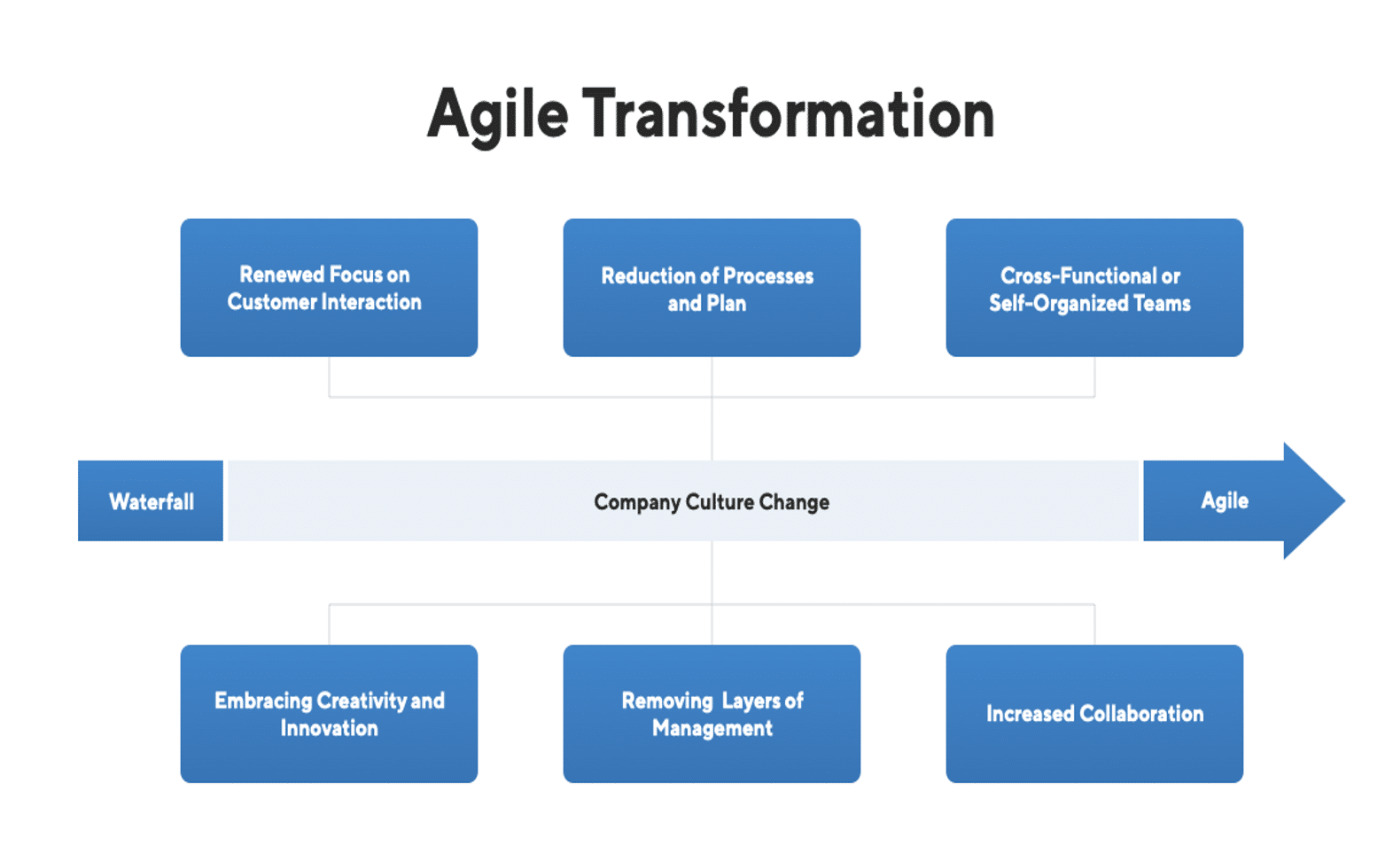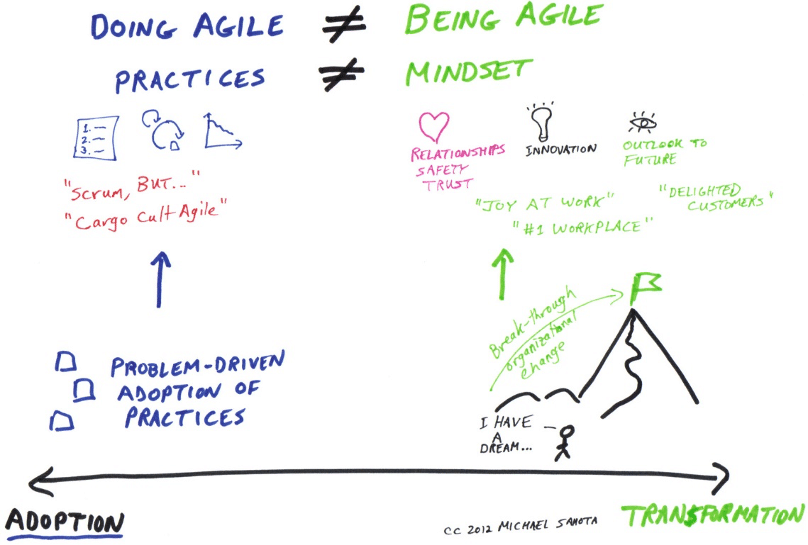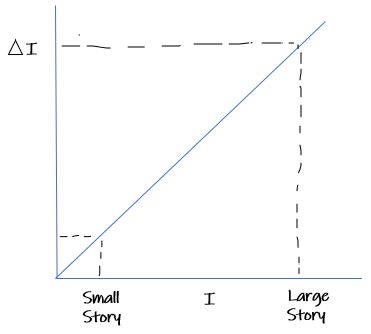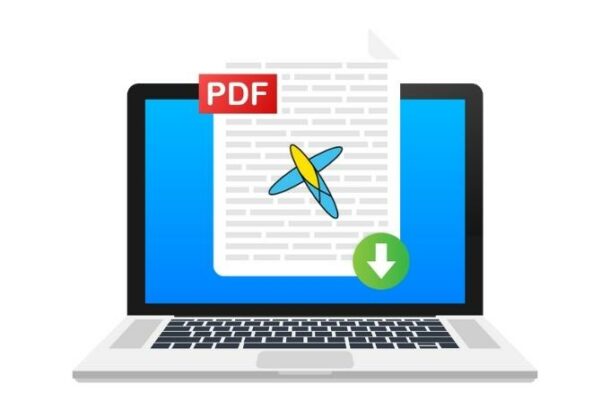
by Krishna Chodipilli | Aug 31, 2022 | Agile Coaching, Leadership Tribe
Real learning is bequeathed from seeking, and seeking is brought forth from asking questions, not giving answers. When you ask a question, you are opening up to a realm of infinite possibilities. But when you are only giving answers, you are trapped in the confines of your understanding. Answers are inhibitors; they restrict the possibilities to the solution offered. Questions, on the other hand, are powerful creators and powerful questions are the harbingers of discovery.
If you’re considering individual or team coaching, read on. The process of team coaching or team facilitation can improve team-building, encourage individual and team creative thinking and improved decision-making and output. Whether it’s executive coaching, agile team facilitation or individual coaching – results can be tangible and so positive.
The coach and the facilitator explained
A coach has mastered the art of asking the right powerful questions. Their competence lies in eliciting the coachee into new design thinking by a process of enquiry. The outcome of such a process is a refined realisation that can be transmuted into ready action. It can have a positive effect on mental health as well as professional performance.
A facilitator’s role, on the other hand, is to create a psychological space that encourages thinking. They influence the group to seek and debate on issues concerning beliefs, values and culture. They encourage doubt. They facilitate a healthy environment and group process wherein members can freely ideate, express and question on predetermined agendas without barriers of guilt, shame or prejudice. Hence, while a coach helps you on a journey of discovery, a facilitator creates visibility of such journeys.
The fundamental distinctions of coaching vs facilitation: common questions answered
-
Coaching is effective with individuals, dyads or very small groups (not more than 10)
-
Facilitation is best complimented for groups, teams, task forces or organisations
-
Coaching focuses primarily on an individual’s ecology and world view
-
Facilitation is focused on the community
-
Coaching services are transactional, usually by one on one meetings or phone calls
-
Facilitation services are issue-based, conducted through group sessions, virtual meetings, webinars or workshops
-
Coaching sessions are more intimate and best-done face to face
-
Facilitation sessions are more dispassionate and best delivered in a ‘one to many forums’.
In agile, coaching and facilitation meet the common ground. Hence the impact is more powerful and sustainable. From the perspective of coaching and facilitation, agile practices enable commonality of function and purpose, as under:
-
Agile presumes the client(s) / participant(s) are creative, resourceful and whole such that they can find their solutions
-
Agile uses various methods to draw or pull information out of the participant(s) / client(s)
-
Agile adopts fundamental coaching and facilitation skills and methods such as Appreciative Inquiry, setting safe environments and relationship guidelines
-
Agile advocates neutrality without taking sides on issues
-
Agile mandates allowing flexibility and adaptability in using different techniques or methods to meet clients’ or stakeholders’ needs
-
Agile facilitation promotes active listening to client needs, to what is being said and more often than not, what is not being said
-
Agile promotes delving deeper into strengths, possibilities, change management and transformation through a journey of realisation and discovery.
The significant advantage of the Agile methodology is that it enables you to master both these roles through an experiential process. Agile is a world where the phenomena of seeking a quest and finding numerous possibilities from it are an everyday occurrence. Being Agile is not about giving solutions, it is about seeking the right, most powerful questions and discovering new ways of doing things and decision-making. In the process, finding powerful and path-breaking personal and professional results.
by Krishna Chodipilli | Aug 28, 2022 | Agile Methodology, Leadership Tribe
How did agile methodology develop?
Running a business requires business people to be on their feet and to make effective decisions in a split second. For, these decisions can affect an entire organisation and its growth, the company’s lifecycle, and operations from stakeholders down to new staff.
The importance of quick and effective decision making is also applicable to the development team and programmers. It is probably why a group of programmers collaborated a long time ago to find ideas and implement them to better themselves and their profession. Their ideas turned to experiments to decide their efficacy and impact of the operations of the programmers, coders and development team. At the time, practices like pair programming, user stories, stand-up meetings, iterative approaches and processes that are used today widely, was, but, just a few experiments. However, among these trials, some ideas failed, while some worked. The group of programmers weren’t disappointed by the failures and chose to work on the new features that worked.
Their steadfast determination led to the formation of principles that are known today, as the Agile Manifesto. The manifesto and the concept of Agile spread like wildfire due to its efficacy in making operations easy and effective. So, much so, that, business people outside the developer world began using these agile methods to run their organisations and to train their executives.
The widespread use of the concepts also led to the formation of practices that hindered the growth of companies and individuals working in them. A certain amount of structure and formality was built around Agile that was a contrast to its beliefs. Ultimately, this lead to concepts like Scrum Teams and Scrum Master. When done right, the concepts are about ensuring a team is able to work together and solve problems through training and coaching. However, without proper training and knowledge about the concepts of Scrum and Agile, the employees can feel like slaves and start disliking the idea.
What does it mean to be agile?
The Agile Manifesto created in 2001 in Utah by seventeen developers talks about various elements of the software development lifecycle:
-
Individuals and interactions over processes and tools
-
Working software over comprehensive documentation
-
Customer collaboration over contract negotiation
-
Responding to change over following a plan
The content of the Agile Manifesto, and the four key values in it, shows the true nature of the Agile model and what it means to be Agile, not just in a software development process such as (FDD: feature-driven development), but in workflow overall. An Agile mindset keeps people as a priority over tools and development processes. The first value of the Agile Manifesto focuses on this point strongly by promoting dynamic communication between teammates and colleagues over a structured one.
Being Agile also means that an individual or company focuses more on the task at hand than the documentation. However, this does not mean it promotes a lack of records. What it tries to propagate is a work culture where individuals don’t waste their time documenting every little detail and following a hierarchy from testers to project managers and developers in getting approvals. Instead, they utilize their time to finish the task effectively and fast across the team – therefore assisting in rapid application development or extreme programming for example.
Agility is a set of practices that involve a product’s end-users in the development process of the same. Unlike negotiation, where the consumer is approached at the start and end of the production. This Agile mindset is more adaptive and can help speed up the process of software development (or services in case of businesses) by constantly checking in the customer’s feedback through smaller milestones and 2 week sprints. Then it is easier to refactor necessary changes based on business needs and customer needs alike avoiding large technical debt.
Being Agile, like its dictionary definition, means to be able to move quickly. The core of the concept of Agility is reacting to change with positivity and fluidity – consider this a continuous integration for instance. So, if one iteration doesn’t work out in the development process, the agile team’s focus is changed in the next sprint.
How do companies implement Agility?
When it comes to implementing Agility in companies, many fail to capture the essence of the concept. They treat it as a medium to improve the performance of an Agile team of employees. It should be used as a tool to transform the work culture of an organisation.
For instance, when one is not able to estimate the results of an experiment precisely. What an Agile-mindset should do is to accept that sometimes there are parameters that are uncontrollable and unpredictable. However, what most companies do is try and bring in new methods to ‘improve’ the ability to estimate, review story points, tweak metrics, refresh/revise the overall strategy or software development method for instance.
The above is one among many such practices and mistakes that individuals and companies alike make in implementing Agile. Moreover, organizations make things worse by adding rigid structure and unrealistic ideas into the mix.
For instance, a manager set a two-week deadline for a task that could use a little time. They asked for daily reports and daily standups, instead of every week. This practice of micromanagement led to the employees being stressed out as they needed to have something to report to the head every day. This kind of practice may get faster results, but they will lack quality. It violates Agility because it can often get caught up in feedback loops, burndown rates or working on projects in very small increments. Being Agile means having the freedom to be self-organizing, to choose your work and set realistic deadlines and be open to changes. Many organizations fail to grasp this and many team members often don’t know when to stand up to it.
Why developers dislike the agile software development methodology
Lack of knowledge
One of the foremost reasons why software developers hate agile is that their managers don’t understand the concept of Agility. They try to utilize the ideas of Agile in a structured manner. In turn, this violates the nature of an Agile-mindset and ends up regressing to traditional project management tactics that they are familiar with.
The fault lies in their understanding of the principles mentioned in the Agile Manifesto. The inability to comprehend the concept makes them implement structure and hierarchy that they are familiar with from experience. This results in a work culture that makes employees feel like they are slaves and pushes them further away from team work and collaborate less often within.
For instance, pressuring the team to follow a short deadline to complete a task that can use a little time. In such situations, the employees subjected to the pressure are exhausted, making them hate working at the company or in a team.
Process-oriented development teams
Another reason developers dislike Agile is the way their superiors treat the concept more as a religion than a process that can increase productivity. Which means, they blindly stick to their beliefs and refuse to budge towards a more agile approach of product management. Consequently, they forget the core of Agility – change.
When superiors have incomplete knowledge of the concept and believe it to be something akin to a religion that can save them, they try to force it on their team. Moreover, they refuse to be flexible with their implementation, thinking they need to follow a rule strictly. Whereas, an Agile framework and Agile mindset within the team’s members should be able to adapt to changes with ease.
When practitioners of Agile fail to grasp the concept itself, it leads to their teams disliking Agility and choose to work against it. This reduces functionality across the team and causes issues overall.
Will to change during a project
The fundamental reason that makes software project managers (and project managers overall) unknowingly violate the principles of Agile is basic human nature. Since childhood, an individual is moulded to listen and take orders from people superior to them. The training remains deep in the consciousness of an individual as they grow to be independent and salaried individuals, including the rebellious ones who flaunts authority.
This nature then is applied in the implementation of Agile with a structured process, as it makes it comfortable to do so. Another reason why individuals don’t wish to be Agile is the core reasoning of the concept and the ability to make the project or product owner responsible for blame. On the other hand, an Agile-mindset not only responds positively to change but also takes responsibility for tasks. As such, if it fails to blame no one other than the individual themselves it puts the risk on them in these changing requirements.
The very idea of taking upon blame or responsibility for failure is scary to such individuals. For, as human beings, they fear failure the most.
Moreover, the usual blame game is not applicable when being Agile. It is not surprising when considering human nature that individuals dislike taking the culpability, and would rather blame a third-party for something that went wrong in the overall project or product development for instance. As such, when a particular idea fails in a strategy one can easily hold the manager responsible or the team leader; or even overall resource – blaming anyone but themselves. However, when applied in a true sense, Agility does not support blaming others and promotes taking responsibility for their own actions. This is one of the aspects that makes individuals dislike Agile.
Are there any lean alternatives to Agile development
The only alternative to Agile processes is Agile alone. The structured and the managerial way the concept of Agility is handled and the human nature causing it is the root cause of why developers dislike Agile and why the concept is not effective sometimes. As such, the only way forward from this slump is to implement the true meaning and essence of Agile.
Managers have to be ready to let go of their false beliefs and be open to change in a decent timeframe. They should try and establish a work culture that focuses its prioritization on Agile, following the four core values and twelve principles of the Agile Manifesto. Only then, would the employees like developers start accepting the concept and applying it effectively in retrospective and for ideas moving forward.
To conclude, Being Agile and having an Agile-mindset is important for the growth of a company, enabling cross-functional teams and therefore its overall productivity. As such, an organization and its executive should implement whatever is necessary to make its employees accept the concept. Through Business Agility programs from institutions like Leadership Tribe, a company can train its managerial staff to make them understand what Agility and being Agile means. Doing so will lead to the staff being better managers who can inspire their teams into being Agile.
The human nature that constantly fights Agility can only be changed by implementing the core values of concept in daily life without limiting it to professional areas. Therefore, to make developers like, and use the concepts of Agility, a manager should be Agile thoroughly. We, at Leadership Tribe, offer Agile methods in our coaching and training to support you and your team members in your journey to being Agile, as well as Kanban, Scrum Methodology, Sprint Planning and more.
Learn more about Agile Project Management and Agile Project delivery frameworks such as Dynamic Systems Development Method (DSDM) with LeadershipTribe and contact us today for more info.
by Krishna Chodipilli | Aug 23, 2022 | Agile Methodology, Leadership And Management, Leadership Tribe
“Thriving in today’s marketplace frequently depends on transforming to become more agile”- Scott M. Graffius
Most organizations are thriving and surviving in the digital era by transitioning towards agile methodology from traditional methods. By adopting agile transitions, they are gaining improvements and substantiative performance, leading to profitability, improved growth, employee engagement and ultimately customer satisfaction. However, many companies claim they are running an agile work environment, but many struggle to take the agile manifesto by heart.
If you’ve ever studied the agile manifesto or got the coaching of agile transitions, you probably will not be surprised that this working style can be a challenge. This manifesto is the disrupter of the traditional status quo which can be uncomfortable for many people. Therefore, many organizations fail to see the kind of results agile promises to deliver, only if properly implemented.
Agile transitioning: a case study
Let’s take an example of Agile transitioning in a well known organizational structure.
The Dutch banking group, ING in 2015, decided to shift from traditional methodology to the Agile Model inspired by the giant market leaders Netflix, Google and Spotify. Fortunately, ING’s new approach boosted their employee engagement, marketing and increased their work progress, clearing out backlogs of tasks and overdue initiatives.
To truly adopt an Agile environment, it takes willingness and commitment to let go of all the conventional method of doing things in the organization. The agile transformation is not just about some fancy jargons and new meeting styles; it’s a whole way of business transformation.
You may immediately want to know how Agile transition works and how the transition from waterfall to agile transformation can work. But before building that agile transformation roadmap, you must know what it is.
What is agile transition?
The agile transition is the transforming act of an organization’s nature or forms progressively to the one that can thrive and embrace a collaborative, self-motivated and flexible fast-paced environment. The agile manifesto principles and values can be exercised and taught in any organization, with agile teams whether small or large. However, the organization needs to understand the agile framework basics and values to get healthy and true agility rewards.

How does an agile transition work?
The agile transition process begins by setting goals, designing a leadership team, and forming an agile transformation roadmap for the team to meet business needs. Organizations create progress check-ins periodically contrary to the planned product roadmap. Then, crucial adjustments/changes are made to keep the project on track while keeping it realistic with these cross-functional teams.
How to transition from waterfall to agile
To make the agile methodology work, the organizations running on the bureaucracy, waterfall project development, or silo management system must embrace the agile transformation roadmap. Employees will need coaching in agile transitions to make the most out of it. They need to understand and embrace the core principles of agile. This requires empowering the employees to work autonomously, to be self-organizing and to be confident in independent decision-making while educating them on rewarding and evaluating the staff in this new business paradigm.
New procedures should be established. New tools must be adopted to facilitate the new work patterns, product management and development process. Each leadership team and employee may need training, ownership and distribution throughout the agile process.
Successful ways to facilitate the transition from waterfall to agile
· Communicate regularly
When you move to agile methods such as scrum training, sprint planning and workflow management methods like Kanban, the teams need to communicate daily. Daily stand-up meetings are a good way to do this. It remains a crucial part of the testing and development activities for agile coaches and teams. Leaders need to understand where the pain points are developing in the team and substitute an environment that makes the best solution to remedy to such issues. In such a growing environment, it’s also vital to be ready for any potential changes. By developing a clear line of knowledge, the development team will keep implementing iterative changes to achieve project deliverables.
· Strengthen the mutual vision for a successful agile transformation
Most organizations are good at making operational and financial goals, but such goals only motivate the upper management or product owners rather than the organization’s average worker. To boost the mutual vision and develop an agile organization, the company needs to reestablish the key performance indicator (KPI) metrics and connect everyone with a more profound sense of purpose. This goal and objective needs to flow top-down, from senior management to those implementing the projects.
Customers and employees are the heart of any business, so step away from the financial projections and charts and ask how your service/product contributes to the world? What would your company’s success mean for employees and customers? What will it mean to you in retrospective?
· Train staff on the agile rollout
Bringing new practices and ideas to the work members could be a disaster. Many professionals are likely to be accustomed to shifting and working to agile practices without guidance, which fails. To perfectly implement agile approaches in an organization, training sessions should be conducted. Also, organizations can look into the institutions that help the teams understand agile through different resources like blogs, seminars and books.
· Encourage collaboration amongst team members
There is no template overall, but agile transition’s essence is collaboration across each individual team. By communicating effectively and collaborating through different tools, the team becomes solid and buy-in towards agile development is encouraged. Companies can also engage agile approaches when testing to ensure that the functionality and requirements of the project/product developments are up to the standard.
· Give everyone time to adjust to the agile transformation strategy
Like Rome wasn’t made in a day, your company will not transition and make an agile transformation in one day either. Whether C-suite, stakeholders, project managers or support teams, when you move groups of people from a conventional project management based system to a result-based system, it always comes with a learning curve and a potential cultural shift in the company. As an organization, you have already few projects lined up, and it’s best to finish them before agile implementation. Don’t try to force buy-in right away, or try to convert every business project into an agile project overnight.
Wrapping-up the agile transformation journey

In a nutshell, agile adoption – converting from traditional waterfall methods to agile methodology is not an easy job as a manager or team. This is an essential aspect for any corporation to understand the core’s agile concept and then deliver it to their employees in order to develop an agile mindset. Managers/leaders can play their part by encouraging business agility, in turn motivating the entire organization and its teams to become adaptable to change. However, if implemented correctly with the proven tips and right coaching, this methodology can take the organization above the sky (like the Dutch banking group example) and increase business value in time.
Contact Leadership Tribe to find out more about preparing for Agile Transitions and build your agile transformation roadmap today
by Krishna Chodipilli | Aug 19, 2022 | Agile Methodology, Leadership Tribe
Many have asked why Fibonacci series is used for the story point estimates. Though I agree, it is not the only way to estimate based on relative sizing and many of them use different methods, Fibonacci sequence is used frequently.
In this article, I would like to help you to get a better understanding of the fundamentals behind using the Fibonacci series. And you won’t even need a deck of cards for this one.
Example Fibonacci sequence – estimated effort
Let’s take a Fibonacci Scale example where you are asked to hold a weight of 2 Kgs.

If the weight is increased by .02 Kgs (i.e. 2.02 Kgs is the total weight), it would be very negligible to notice the difference by the person who lifts the weight especially when they are unaware that it was increased by 0.02 Kgs.
The same is true when a person is asked to lift the weight of 5 Kgs and then it is increased by 0.05 Kgs without them noticing, the person wouldn’t feel the increase in the weight.
Weber in 1834 realised that there is a particular threshold and the ratio, the background intensity to the incremental threshold, is relatively constant.
In the equation, K is constant.
1Δ⊥̅⊥̅=?
ΔI = IK

Coming back to Fibonacci sequence in this series of numbers, an accurate estimate would be 1, 2, 3, 5, 8,13,21,34,55…
However, this modified Fibonacci sequence in Agile estimation world is 1,2,3,5,8,13,20,40…
Each estimation is modified just for the sake of easiness of use of 20,40,80 and 100.
As you understand from the above sequence of Fibonacci numbers, it is clear that 2 is 2 times bigger than 1. However, the gap between 3 to 5 or even between 5 to 8 is not double. These nonlinear sequences work well in the high-level estimates as they reflect great amount of uncertainty. This will prevent one user story being too close to another.
The user stories that would be worked out in upcoming PI planning, would better to be estimated within one order of magnitude.
Enjoy using the planning poker with the above-mentioned Fibonacci series and get better high-level and accurate story estimates. This estimation method will improve project management.
by Krishna Chodipilli | Jul 29, 2022 | Agile Coaching
As we know, productive collaboration between and among agile teams is a fundamental tenet of agile practice. Face-to-face communication in daily meetings forges a shared team dynamic at once attentive and responsive. But the coronavirus has made remote work a reality that’s here to stay; face-to-face meetings now rely on a high bandwidth connection and a well-crafted response to the challenges of the time zones. Demands change and agile adapts.
Virtual team
Remote work by virtual agile squads has its skeptics. Not unreasonably, some think that because online collaboration lacks the immediacy of face-to-face meetings, outcomes may be less productive. But online collaboration is thriving in the workplace and shaping the future of software development. Put skepticism to the side and recognise that globally distributed teams bring powerful advantages to project management and stakeholders alike.
Online, talent and skills from every time zone enter your hiring pool. Businesses may seek the most able employees, and those employees are free to seek the best opportunities. Distributed teams worldwide open possibilities for fresh insights and innovative ideas. Complex agile projects can meet ambitious deadlines as team members working in different time zones hand off assignments to the next waking time zone, achieving in effect a 24 hour / 7 day work week.
But a virtual team needs nurturing, and working in isolation can impact team integration and opportunities for collaboration. There are times when some team members will work without access to stakeholders or even to their team’s scrum master, and their own work and progress may suffer.
Daily stand-up meetings and what are called iteration team syncs make sure that remote team members have all the resources they need. The scrum master can continue to conference with all team members so that goals are on target and methods remain agile.
Whether teams collaborate in person or remotely, agile practices still apply, including the commitment to goals set during Iteration planning, the daily stand-up, and the power of user stories to shape the iterations.
There are powerful collaboration tools to support efficient remote work and project management.
Remote teams
Remote agile teams are committed to agile principles, but there are challenges that must be addressed and tools designed to meet them.
Time zones may be the least agile aspect of remote work. They are immutable. Working with a team in multiple time zones requires thorough planning and support. The first step is to see that distributed teams have the technology they need to work well both separately and within their team. Online meetings, including scrums, standup meetings, retrospectives, and all other events included in iteration execution, depend on technology, a word we use all the time; for distributed teams, it grounds every success.
Remote work is asynchronous
Working together in multiple time zones every team member and every stakeholder participates in an asynchronous product development experience. Focus and flexibility, the same qualities that distinguish face-to-face stand-up meetings and the on-site daily scrum, inform the work in team video conferencing.

Tech tools to span time zones
Online tools that span time zones enable targeted, creative, collaborative, and professional human connection.
- Instant messaging is less time-consuming than email and it lets teams connect and discuss in real-time meetings, webinars, phone systems, and business-based IM platforms.
- Zoom is perfect for small agile teams. With voice and video calls, it can accommodate 1,000 meeting participants or 10,000 webinar viewers.
- WhatsApp is another good choice for remote work. No matter the time zone, this chat tool provides instant messaging, voice calling and video conferencing — and it’s free.
- Slack has earned respect among many agile teams. An instant messaging tool, Trello allows teams to silo conversations in topic or team channels, focusing conversation and helping streamline and clarify the work environment.
- Trello keeps all the integrations, the power-ups, connected in one place. It allows remote teams to break down projects into manageable steps, mark deadlines, and assign task ownership, while preserving at all times a detailed overview of the process.
- Whiteboarding gives quick attention to spontaneous ideas and brainstorming, allowing software development teams to capture, organise, and prioritise them all.
Visual management and virtual tools like these can benefit a remote team in immediate and far-reaching ways. establish virtual routines and restructure the ground rules for collaboration.
PMI and PMP certification
The experience you gain working directly with agile processes is essential to your professional development, and there’s more:
- Agile PMI and PMT certifications will sharpen your agile project management skills for success in every time zone.
- Project Management Institute (PMI®) Project Management Professional (PMP)® Certification
- PMI Agile Certified Practitioner (PMI-ACP)
- Project Management Professional (PMP)® Certification
Leadership Tribe is a globally trusted Agile Training Partner. Our mission is to help you to implement a pragmatic and sustainable business transformation with maximum innovation and minimal disruption. Learn more about virtual agile teams and remote agile planning via our Agile Training courses from Leadership Tribe today.







